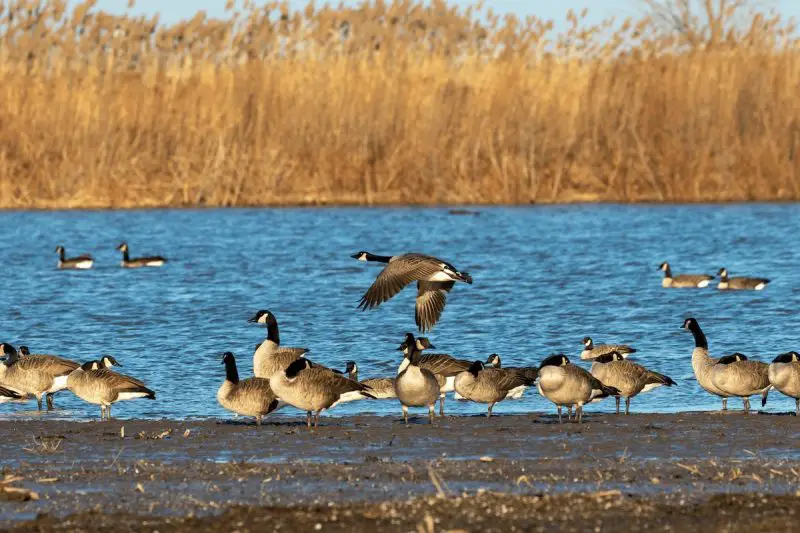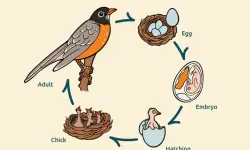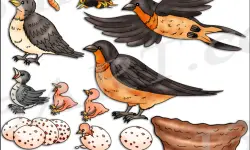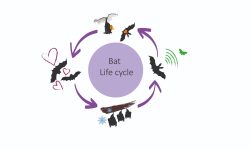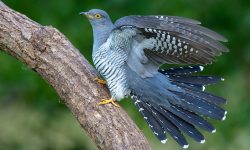Michigan offers prime duck-watching opportunities during spring and fall migrations. Countless ducks, from Northern Pintails to Redheads, pass through the state’s wetlands, adding vibrant biodiversity.
This guide highlights Michigan’s most common migratory ducks, when they arrive, where they go, and how to best observe them throughout the migration season.
Understanding Duck Migration in Michigan
Why Michigan is a Key Stopover
Michigan sits along the Mississippi and Atlantic Flyways—two of North America’s major bird migration routes. Its abundance of inland lakes, rivers, coastal wetlands, and protected wildlife areas make it an essential stopover and breeding destination for migratory ducks. The Great Lakes serve as both navigation landmarks and critical food sources, attracting millions of waterfowl annually.
When Does Migration Occur?
Duck migration in Michigan happens in two major phases each year—spring and fall—corresponding to the birds’ breeding and wintering needs. Spring migration, typically from March to May, marks the return of ducks from their southern wintering grounds to northern breeding territories. During this period, males exhibit vivid breeding plumage and engage in active courtship behaviors, making spring an exciting time for observing species diversity and display behavior.
Fall migration, from September through November, brings a reverse flow of ducks heading south after the breeding season. This is often the peak season for bird watchers in Michigan, as larger numbers of ducks, including fledglings, pass through the state in mixed-species flocks. The wide range of duck species and their sheer abundance make fall a prime time for observation and photography.
Migration timing can vary slightly each year depending on environmental factors. Conditions such as temperature, ice cover, and food availability influence when and how long ducks remain in the state. Mild autumns, for example, may allow ducks to linger into late November, offering extended viewing opportunities for enthusiasts.
Most Common Migratory Ducks in Michigan
Mallard (Anas platyrhynchos)
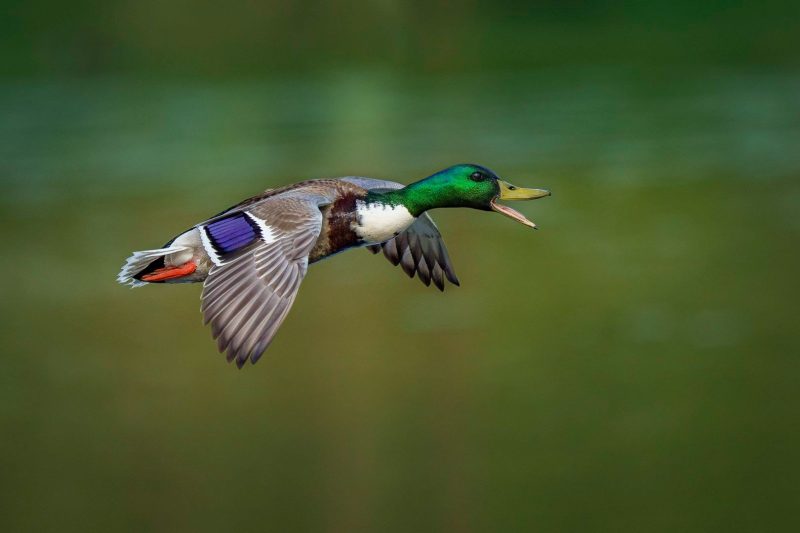
Mallards are one of the most familiar and widespread duck species in North America. The male is easily recognized by his shimmering green head, white neck ring, and rich chestnut breast, while the female has a mottled brown appearance with an orange bill and blue speculum bordered in white. Their adaptability allows them to thrive in diverse habitats, including ponds, marshes, lakes, rivers, and even urban parks across Michigan.
These dabbling ducks are highly migratory in the Great Lakes region. In Michigan, large numbers pass through during both spring and fall, often stopping in wetlands to rest and refuel. Mallards are usually among the first ducks to arrive in early spring and among the last to depart in late autumn, making them a consistent presence throughout the migration season.
Wood Duck (Aix sponsa)
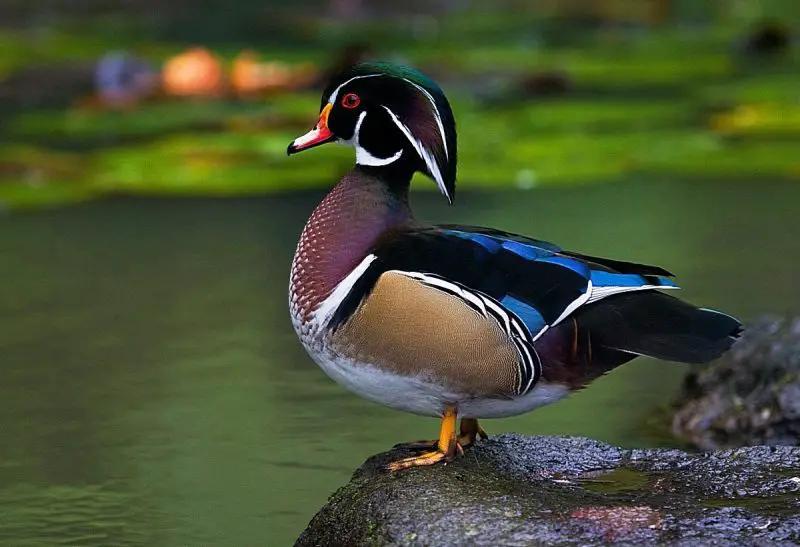
Wood Ducks are prized for their stunning, multicolored iridescent plumage and bright red eyes. Males are especially vibrant, showcasing a glossy green head with bold white markings, while females have more muted tones, marked by a distinctive white teardrop-shaped eye ring that adds to their subtle beauty.
This species prefers habitats like wooded swamps, forested wetlands, and slow-moving streams, where they nest in tree cavities near water. Michigan provides important breeding grounds for Wood Ducks, and most of these birds migrate southward by late October to warmer regions.
Northern Pintail (Anas acuta)

Northern Pintails are slender and elegant ducks, easily recognized by their long necks and strikingly pointed tail feathers, which give the species its name. The males display a rich chocolate-brown head that contrasts sharply with a crisp white neck and chest, extending into a thin white stripe along the side. Females have a more subdued, mottled light brown plumage, which provides excellent camouflage among marsh vegetation.
This species is known for its early spring migration, arriving in Michigan’s wetlands from March onward, and then migrating again in late fall, usually around October to November. They predominantly pass through coastal marshes, flooded fields, and open wetlands, especially in southern Michigan, using these areas as stopover sites to rest and refuel. Northern Pintails feed primarily on seeds, aquatic plants, and small invertebrates, often dabbling in shallow water to forage. Their graceful appearance and swift flight make them a favorite among bird watchers during migration seasons.
Blue-winged Teal (Spatula discors)
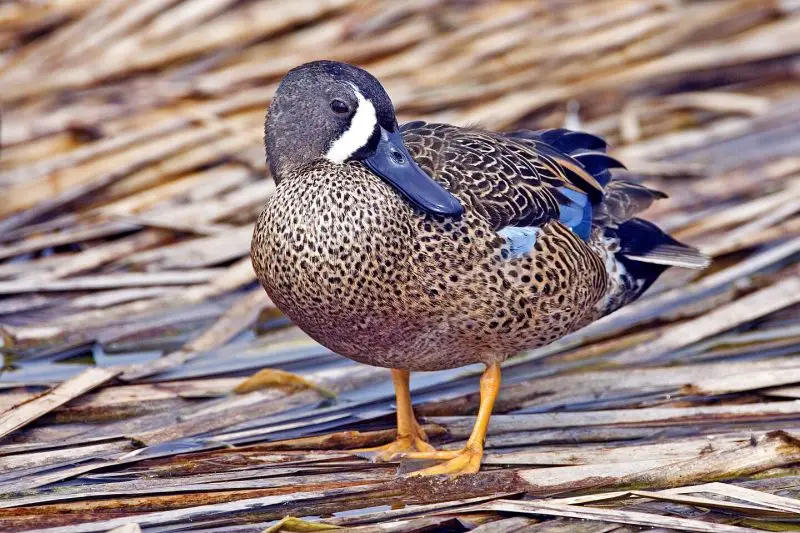
Blue-winged Teals are small, fast, and nimble dabbling ducks, easily identified by the striking powder-blue patches on their wings. Males feature a distinctive white crescent-shaped marking in front of their eyes, contrasting with their slate-gray heads and brown-speckled bodies. Females, in comparison, have mottled brown plumage with more subdued patterns, providing effective camouflage in marsh vegetation.
These teals are among the earliest ducks to begin their southward migration, often departing as early as late summer, typically in August. During migration, they favor shallow freshwater marshes, flooded fields, and wetlands rich in emergent vegetation. These habitats provide abundant food sources, including seeds, aquatic plants, and small invertebrates. In Michigan, Blue-winged Teals usually arrive in spring starting around April, making them some of the first migratory ducks to be seen returning north after winter.
Behaviorally, Blue-winged Teals are highly active and fast flyers, capable of swift and agile maneuvers that help them evade predators. They often feed by “dabbling,” tipping forward in shallow water to forage on seeds and invertebrates near the surface rather than diving. During breeding season, males perform elaborate courtship displays involving head bobs and vocalizations to attract females.
These ducks prefer open wetlands with plentiful vegetation for nesting, typically constructing nests on the ground hidden among grasses and sedges near water. Their adaptability allows them to exploit a variety of wetland environments, but they show a preference for ephemeral wetlands and temporary pools where food is abundant and predators are less frequent.
In Michigan, Blue-winged Teals are a favorite target for bird watchers, especially during migration seasons when large flocks can be seen resting and feeding in flooded agricultural fields and shallow marshes.
Green-winged Teal (Anas crecca)
Green-winged Teals are among the smallest dabbling ducks in North America, notable for their speed and agility in flight. Males exhibit a rich chestnut-colored head adorned with a striking iridescent green patch that runs from the eye toward the back of the head. Females have more muted brown and gray plumage, resembling smaller versions of Mallards but with subtler markings and a more delicate build.
In Michigan, these ducks are most commonly found during the fall migration, frequenting shallow wetlands such as mudflats, marshes, and pond edges. They tend to gather in small, tightly-knit groups, feeding along the shoreline where they forage for seeds, aquatic plants, and tiny invertebrates. Their slender bills and quick movements make them efficient at picking food from the water’s surface or muddy bottoms.
Green-winged Teals are known for their fast, direct flight, often seen darting low over wetlands in coordinated flocks. Their migration timing coincides with the seasonal changes in food availability and water levels, making Michigan’s rich wetlands a crucial stopover point for rest and refueling.
Breeding typically occurs farther north, but during their stopovers in Michigan, these ducks take advantage of the abundant wetland habitats to replenish energy before continuing their journey south.
Redhead (Aythya americana)
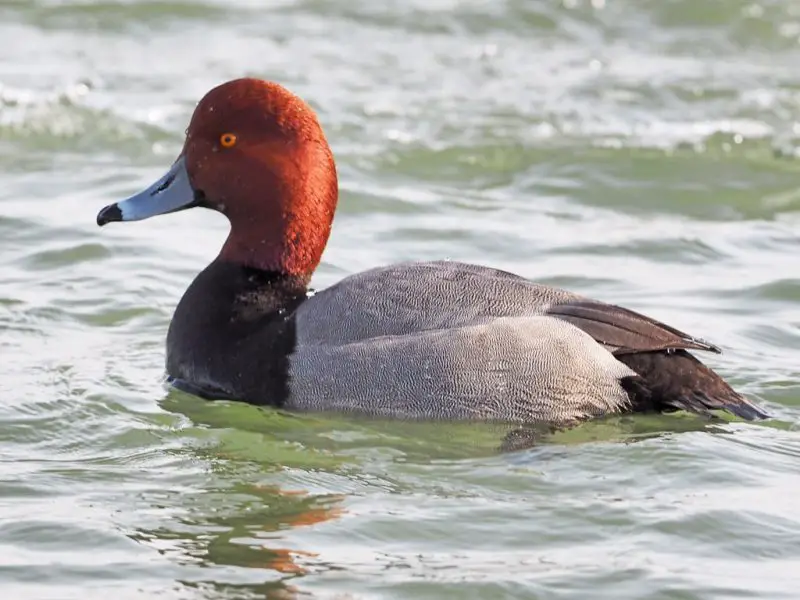
Redheads are medium-sized diving ducks easily recognized by their broad, rounded heads and striking coloration. Males feature rich rufous-red heads contrasted with pale gray bodies and black chests, while females are more subdued in appearance, sporting grayish-brown plumage with pale faces and dark eyes. Both sexes have a distinctive blue-gray bill tipped with black, aiding identification.
These ducks favor deeper bodies of water such as large inland lakes, reservoirs, and deep marshes where they dive to feed on submerged aquatic plants, seeds, and small invertebrates. Their strong diving ability allows them to forage effectively in these habitats, often diving to considerable depths.
In Michigan, Redheads migrate primarily during the later part of the fall season, typically from October through November. During migration, they often gather in sizable flocks mixed with other diving species such as Canvasbacks and various Scaup. These mixed flocks can be seen resting and feeding on large lakes like Saginaw Bay and Lake St. Clair, which provide essential stopover habitats rich in food and shelter.
Redheads are known for their social behavior during migration, forming tight groups that offer protection and facilitate navigation along migratory routes. Their presence in Michigan’s wetlands adds to the diversity and vitality of waterfowl populations during the migration periods.
Canvasback (Aythya valisineria)
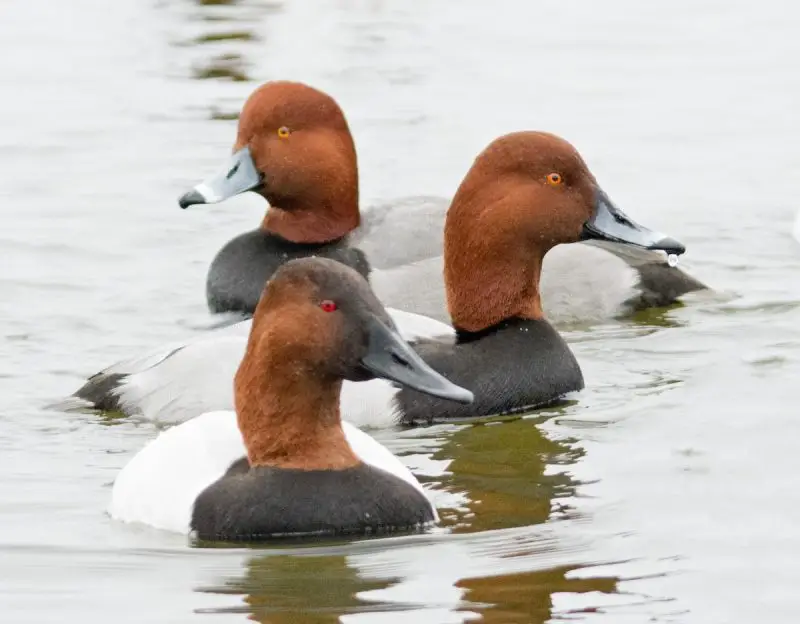
Canvasbacks are elegant diving ducks easily identified by their distinctive long, sloping foreheads and rich chestnut-colored heads. The males exhibit striking bright white bodies contrasted with deep red eyes, creating a sharp visual contrast that makes them stand out among waterfowl. Females, in contrast, display more subdued gray-brown plumage with paler heads and softer red eyes, blending well into marshy environments.
These ducks favor large, open freshwater lakes, reservoirs, and deep marshes where they dive to feed primarily on submerged aquatic vegetation such as wild celery, pondweeds, and other underwater plants, as well as seeds and small invertebrates. Their strong diving skills allow them to forage effectively in deep water, often reaching depths that other dabblers cannot access.
In Michigan, Canvasbacks migrate mostly during the fall, usually between September and November. During this period, they congregate at major inland water bodies including Saginaw Bay and Lake St. Clair. These sites serve as important stopover points where Canvasbacks rest and replenish their energy by feeding on abundant aquatic plants before continuing their southward migration.
Canvasbacks often form large, tight-knit flocks during migration, sometimes mixing with other diving ducks like Redheads and Scaup. Their graceful flight and distinctive profile make them a favorite among bird watchers during the migration seasons.
Northern Shoveler (Spatula clypeata)
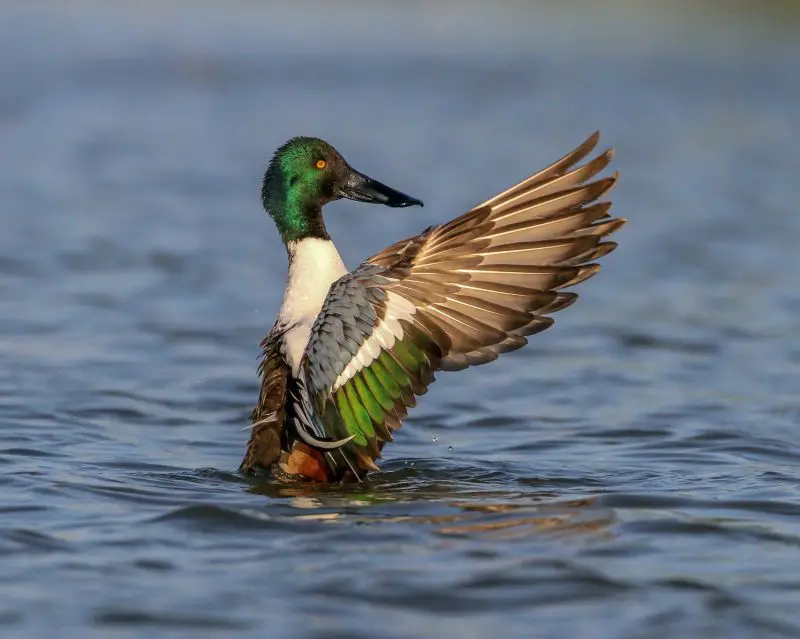
Northern Shovelers are unmistakable among dabbling ducks due to their distinctive, broad, spoon-shaped bills that are specially adapted for filtering food from the water. The males display striking breeding plumage with glossy green heads, bright white chests, and rich chestnut-colored flanks, making them highly visible during the migration and breeding seasons. Females, in contrast, have mottled brown feathers that provide excellent camouflage, along with bright orange bills that stand out against their more muted bodies.
These ducks are early migrants, often arriving in Michigan’s wetlands ahead of many other species during the spring and departing earlier in the fall. They prefer shallow wetlands, flooded meadows, and marsh edges where water is rich in small aquatic invertebrates, seeds, and plankton. Their specialized bills work like fine sieves, allowing them to sweep through the water’s surface to strain out tiny crustaceans, insect larvae, and plant matter, which form the bulk of their diet.
Northern Shovelers are highly active feeders, frequently seen swimming with bills submerged, filtering steadily while moving through their habitats. During migration, they gather in loose groups but often disperse to take advantage of abundant feeding areas. Their presence in Michigan’s wetlands during migration contributes significantly to the diversity and vibrancy of the state’s waterfowl populations.
Gadwall (Mareca strepera)
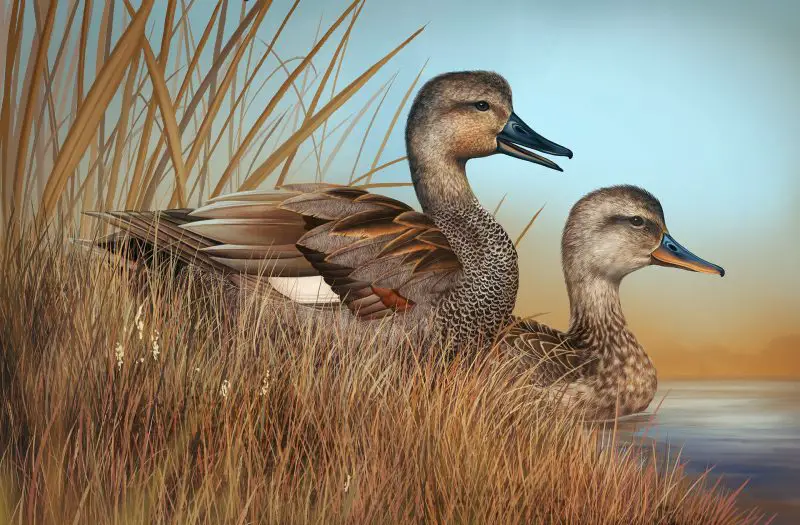
Gadwalls are subtle but graceful ducks, known for their mostly gray-brown plumage accented by distinctive black tail coverts and striking white patches on their wings, visible especially during flight. Females closely resemble males but have more muted, less vivid coloring, helping them blend into their calm freshwater surroundings.
These ducks favor tranquil habitats such as ponds, lakes, and marshes with abundant aquatic vegetation. They migrate steadily through Michigan, with spring movements typically occurring from late March through May, while fall migration happens from October to November. Throughout these periods, Gadwalls are often seen feeding quietly in small groups, dabbling for seeds, aquatic plants, and small invertebrates in shallow waters.
American Wigeon (Mareca americana)
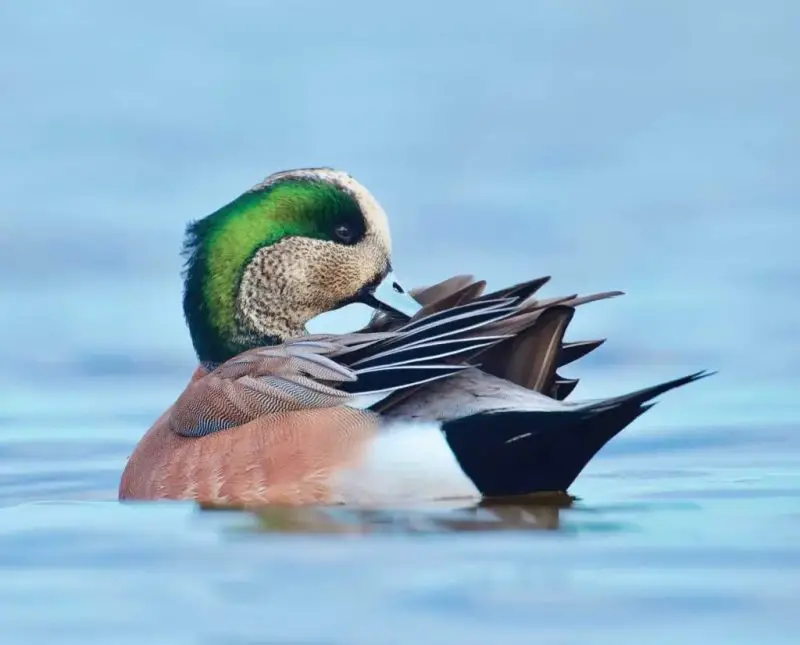
American Wigeons are medium-sized dabbling ducks notable for their compact, rounded heads and relatively short, stout bills. The males are especially distinctive, featuring bright white caps that contrast with vibrant green patches extending from their eyes toward the back of the head, giving them a striking appearance. Females, in contrast, exhibit a more muted palette of pale brown and gray tones, which provides effective camouflage among grasses and marsh vegetation.
These ducks migrate through Michigan twice a year, primarily during the spring and fall seasons. Their migration is marked by large, often noisy flocks that can number in the hundreds, creating an impressive sight for bird watchers. During migration, American Wigeons favor open wetlands, shallow ponds, flooded agricultural fields, and marshy areas where they can graze on aquatic vegetation, grasses, and algae. Their feeding behavior includes both dabbling at the water’s surface and grazing on land, sometimes even joining flocks of Canada geese.
In Michigan, the southern parts of the state are prime locations to observe American Wigeons during migration, especially in wetlands associated with the Great Lakes and inland ponds. Their tendency to gather in large groups makes them relatively easy to spot, and their distinctive calls—soft whistles and short grunts—add to the rich soundscape of migratory waterfowl in these habitats.
Best Places to See Migratory Ducks in Michigan
Saginaw Bay
Saginaw Bay, a large inlet of Lake Huron, serves as a crucial stopover site for thousands of migrating ducks each year. Its diverse landscape, which includes open water, coastal marshes, and inland wetlands, provides excellent habitat for a wide variety of waterfowl species, from dabblers to diving ducks.
During the fall migration, Saginaw Bay becomes especially vibrant as large flocks of Canvasbacks, Redheads, and Scaup gather here to rest and feed before continuing their journey south. This seasonal abundance makes it one of the best places in Michigan for bird watchers to observe migratory ducks in action.
Shiawassee National Wildlife Refuge
Situated in central Michigan, Shiawassee National Wildlife Refuge spans more than 9,000 acres of marshes, floodplains, and carefully managed waterfowl habitats. This refuge is a prime destination for bird watchers, especially during the spring and fall migration seasons.
The refuge supports large populations of ducks such as Mallards, Blue-winged Teal, Gadwalls, and Northern Pintails, offering excellent opportunities to observe these species up close in their natural wetland environment.
Muskegon Wastewater Management System
Though an unconventional location, the Muskegon Wastewater Management System has become a well-known birding hotspot in Michigan. Its network of settling ponds and lagoons creates an unexpected haven for migratory waterfowl, providing essential resting and feeding areas during migration seasons.
Thousands of ducks visit this site each spring and fall, drawn by the abundant aquatic vegetation and invertebrates in the nutrient-rich waters. Among the most commonly spotted species are Redheads, Canvasbacks, and Northern Shovelers, making it a favorite destination for bird watchers seeking diverse and concentrated waterfowl activity in an urban-adjacent setting.
Tips for Observing Migratory Ducks
Bring the Right Gear
When heading out to watch migratory ducks in Michigan, having the right equipment can greatly enhance your experience. A good pair of binoculars or a spotting scope is crucial, as these tools allow you to observe ducks clearly from a distance, minimizing disturbance to their natural behavior. Binoculars with at least 8x magnification are recommended for detailed viewing.
In addition to optics, carrying a comprehensive field guide or a reliable bird identification app on your phone will help you quickly and accurately identify various duck species you encounter. Many apps also include bird calls and range maps, which can be invaluable in the field.
For those who enjoy photography, bringing a camera equipped with a telephoto zoom lens is ideal. This lets you capture sharp, close-up images of ducks without needing to approach them closely, preserving their comfort and natural environment. A tripod can also be helpful to stabilize your shots, especially in low light conditions often found in wetlands. Finally, consider wearing weather-appropriate clothing and waterproof boots to stay comfortable while exploring wetland areas.
Choose the Best Time of Day
The early morning hours just after sunrise and the late afternoon before sunset are typically the most active times for ducks. During these periods, ducks are often busy feeding and moving between resting and foraging areas, making them easier to spot. Additionally, the soft, diffused light of these times creates excellent conditions for photography, reducing harsh shadows and glare.
Calm, overcast days also offer ideal viewing opportunities. The even lighting helps bring out the vivid colors of the ducks’ plumage, and the lack of strong wind means the water surface stays smooth, allowing better reflections and clearer sightings. Planning your outing around these times can maximize both your chances of seeing diverse species and capturing great photos.
Stay Quiet and Minimize Disturbance
When observing ducks, it’s important to move slowly and quietly to avoid startling them. Ducks have keen senses and are easily spooked by sudden movements or loud noises, which can cause them to take flight and disappear from view. Approaching your observation spot with patience and care increases your chances of getting close enough for a good look without causing disturbance.
Whenever possible, use natural cover such as reeds, bushes, or trees to hide your presence. Portable blinds or hides are also excellent tools that allow you to stay concealed while watching or photographing ducks. Minimizing your impact on their environment helps ensure a peaceful experience for both you and the birds.
Follow Local Rules and Respect Nature
Many wetlands and duck habitats in Michigan are protected as wildlife refuges, conservation areas, or regulated hunting zones. It’s crucial to respect these spaces by staying on marked trails and observation points to prevent habitat damage. Always adhere to posted signs and regulations designed to safeguard both the wildlife and visitors.
Avoid approaching or disturbing sensitive areas such as nesting sites or feeding grounds, especially during breeding and migration seasons. By following local rules and showing respect for the natural environment, you help preserve these important ecosystems and ensure that future generations can enjoy the rich birdlife as well.
Conservation and the Future of Migratory Ducks in Michigan
Wetland Loss and Habitat Degradation
Michigan’s wetlands have declined dramatically over the past century, with estimates showing that over 50% of the state’s original wetland areas have been lost or severely altered. This decline is largely due to human activities such as agricultural expansion, urban development, road construction, and drainage projects that convert wetlands into farmland or residential areas. These changes disrupt natural water flow, reduce wetland size, and degrade water quality, all of which negatively impact the ecosystems that support migratory ducks.
Wetlands serve as vital stopover points during migration, providing food resources like aquatic plants, insects, and crustaceans, as well as safe resting spots away from predators. As wetlands disappear or become fragmented, ducks face greater challenges finding adequate habitat to refuel and recover during their long journeys. This loss can lead to decreased survival rates and declining population numbers for some species.
In addition, habitat degradation from pollution, invasive plant species, and climate change further stresses these environments, making restoration and protection efforts crucial. Organizations and government agencies in Michigan are working to conserve and restore wetlands through land acquisition, improved water management, and habitat enhancement projects. These efforts aim to ensure that migratory ducks continue to find the essential habitats they need to thrive during their migrations.
Role of Conservation Programs
Conservation initiatives play a vital role in protecting and restoring the wetland habitats that migratory ducks depend on in Michigan. The North American Waterfowl Management Plan (NAWMP), a collaborative effort between the United States and Canada, focuses on conserving critical waterfowl habitats across the continent. This plan guides large-scale restoration projects that improve wetland quality and increase breeding and stopover areas for ducks.
Local organizations such as Ducks Unlimited also contribute significantly by acquiring land, restoring degraded wetlands, and promoting sustainable land-use practices. Their work helps ensure that vital breeding grounds and migration stopovers remain healthy and productive.
Public support is essential for the success of these conservation efforts. Whether through advocacy, volunteering for habitat restoration projects, or practicing responsible hunting, individuals can help maintain and enhance Michigan’s wetland ecosystems. Sustained community involvement ensures that migratory duck populations continue to thrive for future generations.
Conclusion
Migratory ducks in Michigan offer a spectacular natural event that draws birders, photographers, and nature lovers alike. From the glistening Blue-winged Teal of spring to the dramatic flocks of Canvasbacks in the fall, these seasonal visitors add vibrant life to Michigan’s wetlands.
By understanding migration patterns, knowing the best locations, and practicing responsible wildlife observation, you can fully appreciate the beauty and diversity of ducks in the Great Lakes State. As stewards of these natural spaces, it’s our duty to ensure these birds continue to find safe passage through Michigan for generations to come.

